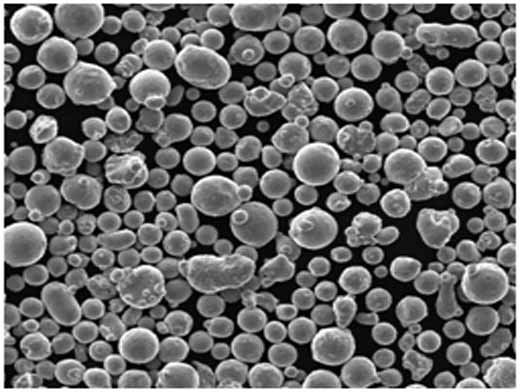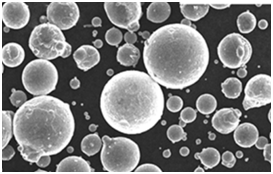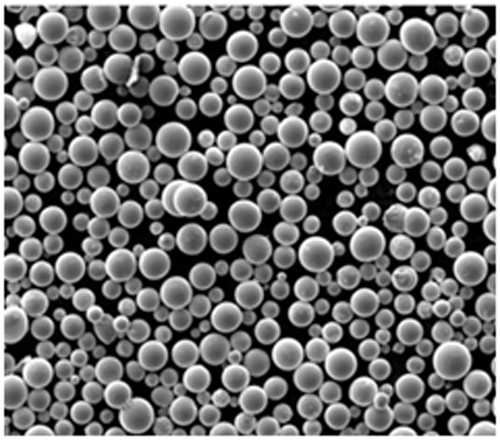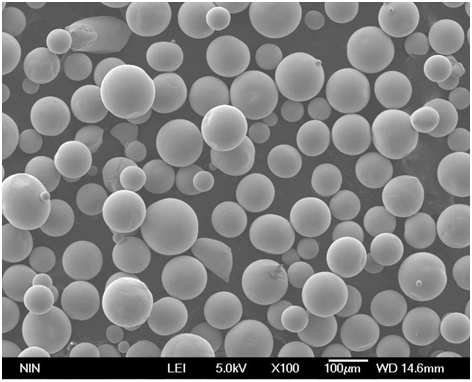Überblick über Pulver aus hochschmelzenden Metallen
Wenn man an Materialien denkt, die extremen Bedingungen standhalten können, sind Refraktärmetalle die unbesungenen Helden des Periodensystems. Diese Metalle werden in einer Vielzahl von Hochtemperaturanwendungen eingesetzt, die von der Luft- und Raumfahrt bis zur industriellen Fertigung reichen. Aber was genau sind Refraktärmetallpulver, und warum sind sie in der Hochtechnologie so wichtig?
Pulver aus hochschmelzenden Metallen sind fein verteilte Partikel von Metallen, die einen außergewöhnlich hohen Schmelzpunkt haben und sehr widerstandsfähig gegen Verschleiß, Korrosion und Verformung sind. Zu den gängigsten Refraktärmetallen gehören Wolfram, Molybdän, Tantal, Niob und Rhenium. Diese Pulver werden bei der Herstellung von Bauteilen verwendet, die unter extremen Bedingungen funktionieren müssen, z. B. in Düsentriebwerken, Kernreaktoren und sogar in der Weltraumforschung.
Die Bedeutung von Refraktärmetallpulvern kann gar nicht hoch genug eingeschätzt werden. Aufgrund ihrer einzigartigen Eigenschaften können sie in Umgebungen eingesetzt werden, in denen andere Materialien versagen würden. Als Ingenieur, Wissenschaftler oder einfach nur als jemand, der sich für moderne Werkstoffe interessiert, ist es wichtig, die Eigenschaften, Anwendungen und verschiedenen Arten dieser Pulver zu verstehen.
Dieser Artikel taucht tief in die Welt der Refraktärmetallpulver ein und untersucht alles, von der Zusammensetzung bis zu den Anwendungen, und bietet sogar einen detaillierten Vergleich der verschiedenen Typen. Lassen Sie uns diese technische Reise gemeinsam antreten.

Arten und Zusammensetzung von Refraktärmetallpulvern
Es gibt verschiedene Arten von Refraktärmetallpulvern, von denen jedes seine eigene Zusammensetzung und Eigenschaften hat. Im Folgenden werden einige der am häufigsten verwendeten Refraktärmetallpulver im Detail vorgestellt:
| Metall-Pulver | Zusammensetzung | Schmelzpunkt | Dichte | Wesentliche Merkmale |
|---|---|---|---|---|
| Tungsten (W) | Pure tungsten | 3,422°C | 19.25 g/cm³ | Höchster Schmelzpunkt, ausgezeichnete Hochtemperaturfestigkeit und Leitfähigkeit. |
| Molybdän (Mo) | Reines Molybdän | 2,623°C | 10.22 g/cm³ | Gute Wärmeleitfähigkeit, Korrosionsbeständigkeit und geringe Wärmeausdehnung. |
| Tantal (Ta) | Reines Tantal | 3,017°C | 16.69 g/cm³ | Hohe Duktilität, ausgezeichnete Korrosionsbeständigkeit und Biokompatibilität. |
| Niobium (Nb) | Reines Niobium | 2,468°C | 8.57 g/cm³ | Hoher Schmelzpunkt, hervorragende Korrosionsbeständigkeit und supraleitende Eigenschaften. |
| Rhenium (Re) | Reines Rhenium | 3,185°C | 21.02 g/cm³ | Extrem hoher Schmelzpunkt, gute Verschleißfestigkeit und katalytische Eigenschaften. |
| Chrom (Cr) | Reines Chrom | 1,907°C | 7,19 g/cm³ | Hohe Härte, Korrosionsbeständigkeit und reflektierende Eigenschaften. |
| Hafnium (Hf) | Reines Hafnium | 2,233°C | 13.31 g/cm³ | Ausgezeichnete Korrosionsbeständigkeit, hoher Schmelzpunkt und neutronenabsorbierende Eigenschaften. |
| Zirkonium (Zr) | Reines Zirkonium | 1,855°C | 6.52 g/cm³ | Hohe Korrosionsbeständigkeit, geringer Neutroneneinfangquerschnitt und gute Duktilität. |
| Iridium (Ir) | Reines Iridium | 2,446°C | 22.56 g/cm³ | Äußerst hohe Dichte, ausgezeichnete Korrosionsbeständigkeit und hoher Schmelzpunkt. |
| Osmium (Os) | Reines Osmium | 3,033°C | 22.59 g/cm³ | Höchste Dichte, hohe Härte und ausgezeichnete Verschleißfestigkeit. |
Merkmale von Pulver aus hochschmelzenden Metallen
Was also macht Refraktärmetallpulver so besonders? Es liegt an den Eigenschaften. Diese Pulver verfügen über Eigenschaften, die nicht nur einzigartig, sondern auch für hochbeanspruchte Anwendungen unerlässlich sind. Schauen wir uns diese Eigenschaften einmal genauer an:
- Hohe Schmelzpunkte: Das bemerkenswerteste Merkmal der hochschmelzenden Metalle ist ihr unglaublich hoher Schmelzpunkt, der oft über 2.000 °C liegt. Wolfram zum Beispiel hat mit 3.422 °C den höchsten Schmelzpunkt aller Metalle. Diese Eigenschaft macht diese Metalle unentbehrlich für Anwendungen, bei denen extreme Hitze eine Rolle spielt, wie z. B. bei Raketendüsen und Ofenkomponenten.
- Hohe Dichte: Refraktärmetalle wie Wolfram und Rhenium sind für ihre hohe Dichte bekannt. Das macht sie ideal für Anwendungen, bei denen Materialien benötigt werden, die erhebliche Mengen an kinetischer Energie absorbieren können, wie z. B. bei panzerbrechender Munition.
- Korrosionsbeständigkeit: Viele Refraktärmetalle, insbesondere Tantal und Niob, weisen eine hervorragende Korrosionsbeständigkeit auf, selbst in rauen chemischen Umgebungen. Dies macht sie ideal für die Verwendung in chemischen Verarbeitungsanlagen und medizinischen Implantaten.
- Verschleißfestigkeit: Die hohe Härte hochschmelzender Metalle wie Chrom und Osmium sorgt für eine hervorragende Verschleißfestigkeit, so dass sie sich für Schneidwerkzeuge, verschleißfeste Beschichtungen und hochbelastbare Bauteile eignen.
- Wärmeleitfähigkeit und elektrische Leitfähigkeit: Trotz ihres hohen Schmelzpunkts besitzen viele Refraktärmetalle auch eine gute thermische und elektrische Leitfähigkeit. Dies gilt insbesondere für Wolfram und Molybdän, was sie für elektrische Kontakte und Heizelemente nützlich macht.
- Duktilität und Bearbeitbarkeit: Während einige Refraktärmetalle für ihre Härte bekannt sind, sind andere, wie Tantal, sehr dehnbar, d. h. sie können zu dünnen Drähten gezogen werden, ohne zu brechen. Diese Duktilität ist in Anwendungen wie Elektronik und Luft- und Raumfahrttechnik von entscheidender Bedeutung.
Anwendungen von Refraktärmetallpulvern
Angesichts ihrer einzigartigen Eigenschaften ist es nicht verwunderlich, dass Refraktärmetallpulver in einer Vielzahl von Anwendungen zum Einsatz kommen. Hier ein Blick darauf, wo diese Materialien üblicherweise eingesetzt werden:
| Anmeldung | Pulver aus hochschmelzendem Metall | Zweck |
|---|---|---|
| Komponenten für die Luft- und Raumfahrt | Wolfram, Molybdän | Hochtemperaturbeständigkeit in Raketentriebwerken, Hitzeschilden und Turbinenschaufeln. |
| Kernreaktoren | Zirkonium, Hafnium | Neutronenabsorption, Korrosionsbeständigkeit und strukturelle Komponenten in Reaktoren. |
| Medizinische Implantate | Tantal, Niob | Biokompatibilität und Korrosionsbeständigkeit von Implantaten und Prothetik. |
| Elektronik | Wolfram, Tantal | Verwendung in Kondensatoren, Widerständen und anderen elektronischen Bauteilen aufgrund ihrer Leitfähigkeit und Stabilität. |
| Schneidewerkzeuge | Wolfram, Chrom | Verschleißfestigkeit und Haltbarkeit bei Schneid-, Bohr- und Bergbauwerkzeugen. |
| Ausrüstung für die chemische Verarbeitung | Tantal, Molybdän | Korrosionsbeständigkeit in Geräten zur Handhabung von Säuren und Chemikalien. |
| Verteidigung und Munition | Wolfram, Osmium | Hochdichte Materialien für panzerbrechende Munition und Penetratoren. |
| Katalysatoren in chemischen Reaktionen | Rhenium, Iridium | Katalytische Eigenschaften bei chemischen Reaktionen, z. B. bei Raffinations- und Syntheseprozessen. |
| Supraleiter | Niobium | Supraleitende Eigenschaften in Magneten, MRI-Geräten und Teilchenbeschleunigern. |
| Juwelen und Uhren | Wolfram, Platin | Hohe Haltbarkeit, Korrosionsbeständigkeit und Ästhetik bei Luxusartikeln. |






Spezifikationen, Größen, Güteklassen und Normen
Beim Umgang mit Refraktärmetallpulvern ist es wichtig, die Spezifikationen, Größen, Sorten und Normen zu kennen, die für ihre Verwendung gelten. Diese Parameter stellen sicher, dass das richtige Material für die richtige Anwendung verwendet wird und dass die Leistung konsistent und zuverlässig ist.
| Hochschmelzendes Metall | Partikelgröße | Klasse | Standard | Typische Anwendung |
|---|---|---|---|---|
| Tungsten | 0.5 – 10 µm | W1, W2, W3 | ASTM B777 | Hochtemperaturbauteile, elektrische Kontakte. |
| Molybdän | 1 – 15 µm | Mo1, Mo2 | ASTM B386 | Heizelemente, thermische Spritzschichten. |
| Tantal | 0.5 – 5 µm | Ta1, Ta2 | ASTM B521 | Medizinische Implantate, chemische Verarbeitungsgeräte. |
| Niobium | 1 – 20 µm | Nb1, Nb2 | ASTM B392 | Supraleiter, Kernreaktoren. |
| Rhenium | 0.1 – 5 µm | Re1, Re2 | ASTM F1760 | Katalysatoren, Hochtemperatur-Thermoelemente. |
| Chrom | 1 – 50 µm | Cr1, Cr2 | ASTM B835 | Verschleißfeste Beschichtungen, Herstellung von Legierungen. |
| Hafnium | 0.2 – 10 µm | Hf1, Hf2 | ASTM B776 | Kernreaktoren, Komponenten für die Luft- und Raumfahrt. |
| Zirkonium | 1 – 25 µm | Zr1, Zr2 | ASTM B551 | Chemische Verarbeitung, Kernreaktoren. |
| Iridium | 0.1 – 10 µm | Ir1, Ir2 | ASTM B785 | Elektrische Kontakte, Zündkerzen. |
| Osmium | 0.5 – 5 µm | Os1, Os2 | Kundenspezifische Spezifikationen | Verschleißfeste Beschichtungen, Herstellung von Legierungen. |
Lieferanten und Preisangaben
Die Suche nach dem richtigen Anbieter für Pulver aus hochschmelzenden Metallen ist von entscheidender Bedeutung, da die Qualität und Konsistenz des Pulvers Ihre Anwendung erheblich beeinflussen kann. Die Preisgestaltung kann je nach Faktoren wie Reinheit, Partikelgröße und Dynamik der Lieferkette variieren.
| Anbieter | Angebotene hochschmelzende Metalle | Durchschnittspreis (pro kg) | Region | Spezialität |
|---|---|---|---|---|
| H.C. Starck | Wolfram, Molybdän, Tantal, Niob | $500 – $2,000 | Global | Hochreine Pulver, kundenspezifische Partikelgrößen, gleichbleibende Qualität. |
| Global Wolfram & Pulver | Wolfram, Rhenium, Tantal | $600 – $2,500 | Nordamerika, Europa | Hochleistungspulver für Luft- und Raumfahrt, Verteidigung und industrielle Anwendungen. |
| ATI | Wolfram, Hafnium, Zirkonium | $450 – $1,800 | Vereinigte Staaten | Zuverlässige Versorgung kritischer Industrien, breite Palette an Refraktärmetallen. |
| Plansee | Molybdän, Wolfram, Niob | $400 – $1,500 | Europa, Asien | Spezialisiert auf Hochtemperaturanwendungen, Herstellung von Sonderlegierungen. |
| Rhenium-Legierungen, Inc. | Rhenium, Molybdän-Rhenium-Legierungen | $2,000 – $10,000 | Vereinigte Staaten | Nischenmärkte, maßgeschneiderte Legierungen, Hochleistungswerkstoffe. |
| Zhuzhou Cemented Carbide Gruppe | Wolfram, Chrom, Tantal | $300 – $1,200 | China | Produktion in großem Maßstab, wettbewerbsfähige Preise, zuverlässige Qualität. |
| Treibacher Industrie AG | Wolfram, Tantal, Niob | $500 – $2,000 | Europa, Nordamerika | Hochreine Materialien, kundenspezifische Lösungen, starke F&E-Unterstützung. |
| CBMM | Niobium | $800 – $3,000 | Global | Führender Hersteller von Niobium, starker Fokus auf Qualität und Innovation. |
| JSC Chepetsky | Zirkonium, Hafnium | $600 – $2,200 | Russland, Europa | Spezialisiert auf nukleare Materialien und hochreine Pulver. |
| Amerikanische Elemente | Alle hochschmelzenden Metalle | $400 – $10,000 | Global | Breites Produktsortiment, kleine bis große Mengen, Schwerpunkt auf Innovation. |
Vorteile und Einschränkungen von Refraktärmetallpulvern
Refraktäre Metallpulver bieten zwar unglaubliche Vorteile, haben aber auch gewisse Einschränkungen. Hier finden Sie einen Vergleich ihrer Vor- und Nachteile:
| Vorteil | Begrenzung |
|---|---|
| Hochtemperaturbeständigkeit: Refraktärmetalle können extremen Temperaturen standhalten und sind daher ideal für hochbelastete Anwendungen wie Luft- und Raumfahrt und Kernreaktoren. | Kosten: Diese Metalle sind aufgrund ihrer Seltenheit und der Komplexität ihrer Gewinnung und Verarbeitung oft teuer. |
| Korrosionsbeständigkeit: Metalle wie Tantal und Niob sind äußerst korrosionsbeständig und eignen sich daher für die chemische Verarbeitung und medizinische Anwendungen. | Schwierigkeit der Bearbeitung: Einige Refraktärmetalle sind aufgrund ihrer Härte und Sprödigkeit schwer zu bearbeiten. |
| Hohe Dichte: Aufgrund ihrer hohen Dichte eignen sich Metalle wie Wolfram und Osmium für Anwendungen, die ein hohes Gewicht und die Absorption kinetischer Energie erfordern, wie z. B. in der Verteidigungs- und Raumfahrtindustrie. | Verfügbarkeit: Bestimmte Refraktärmetalle, wie Rhenium und Iridium, sind selten und nur begrenzt verfügbar, was zu Problemen in der Lieferkette führen kann. |
| Verschleißfestigkeit: Hochschmelzende Metalle wie Chrom bieten eine hervorragende Verschleißfestigkeit, die für Schneidwerkzeuge und verschleißfeste Beschichtungen entscheidend ist. | Oxidation: Einige Refraktärmetalle, insbesondere Molybdän und Wolfram, neigen bei hohen Temperaturen zur Oxidation, sofern sie nicht durch Beschichtungen oder in einer inerten Umgebung geschützt sind. |
| Duktilität: Metalle wie Tantal sind sehr dehnbar und lassen sich in komplexe Formen bringen, ohne zu brechen, was für elektronische Bauteile und medizinische Geräte unerlässlich ist. | Toxizität: Einige Refraktärmetalle und ihre Verbindungen können giftig sein und erfordern eine sorgfältige Handhabung und Entsorgung. |

FAQs
| Frage | Antwort |
|---|---|
| Was sind Refraktärmetallpulver? | Refraktärmetallpulver sind feine Metallpartikel mit hohem Schmelzpunkt, die in Anwendungen eingesetzt werden, die extreme Hitze- und Verschleißfestigkeit erfordern. |
| Warum sind hochschmelzende Metalle teuer? | Diese Metalle sind oft selten und schwierig zu gewinnen und zu verarbeiten, was ihre Kosten in die Höhe treibt. |
| Welches ist das härteste Refraktärmetall? | Wolfram gilt als das härteste Refraktärmetall mit einer Mohshärte von 7,5. |
| Können hochschmelzende Metalle bearbeitet werden? | Ja, aber einige sind aufgrund ihrer Härte und Sprödigkeit schwer zu bearbeiten und erfordern spezielle Werkzeuge und Techniken. |
| Sind hochschmelzende Metalle sicher in der Anwendung? | Im Allgemeinen ja, aber einige können in bestimmten Formen giftig oder gefährlich sein und erfordern eine angemessene Handhabung und Sicherheitsvorkehrungen. |
| Welches hochschmelzende Metall hat den höchsten Schmelzpunkt? | Wolfram hat mit 3.422 °C den höchsten Schmelzpunkt aller Metalle. |
| Wie werden Refraktärmetallpulver hergestellt? | Sie werden in der Regel durch Verfahren wie Wasserstoffreduktion, carbothermische Reduktion oder Elektrolyse hergestellt. |
| In welchen Branchen werden Refraktärmetallpulver verwendet? | Branchen wie Luft- und Raumfahrt, Verteidigung, Elektronik, Medizin, Nuklearindustrie und chemische Verarbeitung verwenden diese Pulver in großem Umfang. |
| Können hochschmelzende Metalle der Korrosion widerstehen? | Ja, Metalle wie Tantal und Niob sind sehr korrosionsbeständig, selbst in aggressiven chemischen Umgebungen. |
| Warum sind hochschmelzende Metalle in Kernreaktoren wichtig? | Ihr hoher Schmelzpunkt und ihre Beständigkeit gegen Strahlenschäden machen sie zu unverzichtbaren Bestandteilen von Kernreaktoren. |

